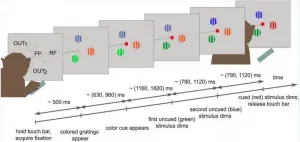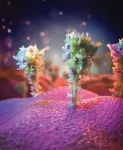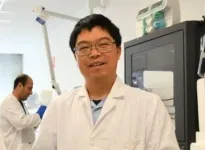Using AI to diagnose neurological diseases based on motor impairment
New Heidelberg approach: Analyzing movement patterns through machine learning
2021-04-07
(Press-News.org) The way we move says a lot about the state of our brain. While normal motor behaviour points to a healthy brain function, deviations can indicate impairments owing to neurological diseases. The observation and evaluation of movement patterns is therefore part of basic research, and is likewise one of the most important instruments for non-invasive diagnostics in clinical applications. Under the leadership of computer scientist Prof. Dr Björn Ommer and in collaboration with researchers from Switzerland, a new computer-based approach in this context has been developed at Heidelberg University. As studies inter alia with human test persons have shown, this approach enables the fully automatic recognition of motor impairments and, through their analysis, provides information about the type of the underlying diseases with the aid of artificial intelligence.
For the computer-supported movement analysis, subjects usually have to be tagged with reflective markings or virtual markers have to be applied to the video material produced in the framework of the assessment. Both procedures are comparatively complicated. Furthermore, conspicuous movement behaviour has to be known in advance so that it can be further examined. "A real diagnostic tool should not only confirm motor disorders but be able to recognise them in the first place and classify them correctly," explains Prof. Ommer, who heads the Computer Vision group at the Interdisciplinary Center for Scientific Computing at Heidelberg University.
Precisely that is made possible by the novel diagnostic method developed by his team, and known as "unsupervised behaviour analysis and magnification using deep learning" (uBAM). The underlying algorithm is based on machine learning using artificial neural networks and it recognises independently and fully automatically characteristic behaviour and pathological deviations, as the Heidelberg scientist explains. The algorithm determines what body part is affected and functions as a kind of magnifying glass for behavioural patterns by highlighting different types of deviation directly in the video and making them visible. As part of this, the relevant video material is compared with other healthy or likewise impaired subjects. Progress in treating motor disorders can also be documented and analysed in this way. According to Prof. Ommer, conclusions can also be drawn about the neuronal activity in the brain.
The basis for the uBAM interface is a so-called convolutional neural network, a type of neural network that is used for image recognition and image processing purposes especially. The scientists trained the network to identify similar movement behaviour in the case of different subjects, even in spite of great differences in their outward appearance. That is possible because the artificial intelligence can distinguish between posture and appearance. Besides the recognition and quantification of impairments, a detailed analysis of the symptoms is also important. "To study them in detail, we use a generative neural network," says Prof. Ommer. "That way we can help neuroscientists and clinicians focus on subtle deviations in motor behaviour that are likely to be overlooked with the naked eye, and make them easily visible by magnifying the deviation. Then we can exactly demarcate the type of disease in the individual case."
The research team has already been able to prove the effectiveness of this new approach with the aid of different animal models and studies with human patients. They tested, inter alia, the precision with which uBAM can differentiate between healthy and impaired motor activity. In their publication on the topic, the scientists report a very high retrieval rate both in mice and human patients. "In all, our study shows that, as compared to conventional methods, the approach based on artificial intelligence delivers more detailed results with significantly less effort," Björn Ommer emphasises.
With respect to the application, the scientists hope that uBAM will be used both in basic biomedical research and in clinical diagnostics and beyond. Prof. Ommer: "The interface can be applied where traditional methods prove too complicated, tedious, or not efficient enough. Potentially it could lead to a better understanding of neuronal processes in the brain and the development of new therapeutic options."
Besides the Heidelberg researchers working with Prof. Ommer, scientists from the University of Zurich and University Hospital Zurich, Balgrist University Hospital and the Neuroscience Center Zurich were also involved in developing the uBAM interface. Part of the funding for the study came from the German Research Foundation as well as the Branco Weiss Fellowship Society in Science and the Swiss National Foundation. The results were published in the journal "Nature Machine Intelligence".
INFORMATION:
ELSE PRESS RELEASES FROM THIS DATE:
2021-04-07
It is more complicated than copy and paste, but digital twins could be way of future manufacturing according to researchers from the University of Kentucky. They developed a virtual environment based on human-robot interactions that can mirror the physical set up of a welder and their project. Called a digital twin, the prototype has implications for evolving manufacturing systems and training novice welders. They published their work in the IEEE/CAA Journal of Automatica Sinica (Volume 8, Issue 2, February 2021).
"This human-robot interaction working style helps to enhance the human users' operational productivity and ...
2021-04-07
To effectively perform any daily task, the human brain needs to process information from the outside world using various cognitive functions. This cognitive processing passes through a dense interconnected network of cells whose physiology is specialized. The interconnected cell network needs to perform this processing of information efficiently and interact cooperatively to provide us, in real time, with useful instructions for living.
Research published on 23 March in the journal Proceedings of the National Academy of Sciences of the United States of America challenges recent scientific advances seeking to find out how cognitive control and sensory information relate to the cortical machinery ...
2021-04-07
New research has for the first time compared images of the protein spikes that develop on the surface of cells exposed to the Oxford-AstraZeneca vaccine to the protein spike of the SARS-CoV-19 coronavirus. The images show that the spikes are highly similar to those of the virus and support the modified adenovirus used in the vaccine as a leading platform to combat COVID-19.
The SARS-CoV-2 virus, which causes COVID-19, has a large number of spikes sticking out of its surface that it uses to attach to, and enter, cells in the human body. These spikes are coated in sugars, known as ...
2021-04-07
Researchers at the Francis Crick Institute, as part of an international collaboration of scientists through the Pan-Cancer Analysis of Whole Genomes Consortium, have analysed the whole genomes of tumour samples from over 2,600 patients with different types of cancer. They identified a high prevalence of genetic diversity within individual tumours, which they further characterised. Their findings confirm that, even at late stages of development, tumour evolution is driven by changes that benefit the cancer.
When cancer cells divide, errors occur in the process of copying their DNA. These copying errors mean that different tumours can be made up of cells presenting a wide range of genetic diversity. This variation is a challenge for doctors as a treatment that ...
2021-04-07
Digitalisation can support transitions towards a more sustainable society if technologies and processes are designed in line with suitable criteria. This requires a systemic focus on the risks and benefits of digital technologies across the three dimensions of sustainable development: the environment, society, and the economy. This is the conclusion of a study prepared by a team of researchers at the Institute for Advanced Sustainability Studies (IASS) in Potsdam. Applying this precautionary approach to digitalisation requires the active involvement of developers, users, and regulators.
Digitalisation ...
2021-04-07
ALS is a progressive neurological disease that attacks the nerves that interact with the body's muscles. The disease typically leads to complete paralysis of the body, robbing patients of their ability to walk, speak, eat and breathe.
Researchers studied ALS patients and healthy elderly volunteers living in Malta who took part in an ongoing study aiming at identifying genetic and environmental risk factors. Malta is a sovereign microstate in the middle of the Mediterranean Sea, and is home to a geographically and culturally isolated population. Recently, Maltese ALS patients were found to have a unique genetic makeup compared to ...
2021-04-07
Bishop Peder Winstrup died in 1679, and is one of the most well-preserved human bodies from the 1600s. Researchers at Lund University in Sweden may now have solved the mystery of why a foetus was hidden in his coffin in Lund Cathedral. DNA from the bishop and the foetus, along with kinship analyses, has shown that the child was probably the bishop's own grandson.
Something is protruding between Bishop Peder Winstrup's two calves. The X-ray reveals small bones. Could it be an animal? When the image is studied more closely, the osteologists from Lund University can see faint signs of what is to become ...
2021-04-07
A novel way to pinpoint and illuminate bone damage promises to make X-rays more efficient at diagnosing bone and other injuries, Flinders University researchers say.
The new technique, looking at potential biomedical applications of an ancient inorganic salt-based aggregation induced emission (AIE) radio-luminescence material, could open new frontiers in medicine including X-ray dosimetry, bioimaging and advanced applications such as optogenetics, says Professor Youhong Tang, from Flinders University's College of Science and Engineering.
The review article, published by Professor Tang, postdoctoral student Dr Javad Tavokoli, colleagues in Hong Kong and Australian technology company Micro-X and, examined the potential of the AIEgen luminogens ...
2021-04-07
Sweden's acclaimed research on uterine transplants has taken a new step forward: into the field of health economics. Now, for the first time, there is a scientifically based estimate of how much implementing the treatment costs.
The current research is based on the nine uterine transplants from living donors carried out in 2013, under the leadership of Mats Brännström, Professor of Obstetrics and Gynecology at Sahlgrenska Academy, University of Gothenburg, and Chief Physician at Sahlgrenska University Hospital.
The transplants were performed within the scope of the world's first systematic, scientifically based study in the field. After ...
2021-04-07
If relatives of people with mental illness become better at accepting the difficult emotions and life events they experience - which is what training in compassion is about - their anxiety, depression and stress is reduced. These are the results of a new study from the Danish Center for Mindfulness at Aarhus University.
Being a relative of a person with a mental illness can be very burdensome. It can feel like a great responsibility, and many people struggle with feelings of fear, guilt, shame and anger. A new study from the Danish Center for Mindfulness shows that eight weeks of training in compassion can significantly improve the well-being of relatives.
Compassion is a human quality that is anchored in the recognition of and desire to relieve ...
LAST 30 PRESS RELEASES:
[Press-News.org] Using AI to diagnose neurological diseases based on motor impairment
New Heidelberg approach: Analyzing movement patterns through machine learning




